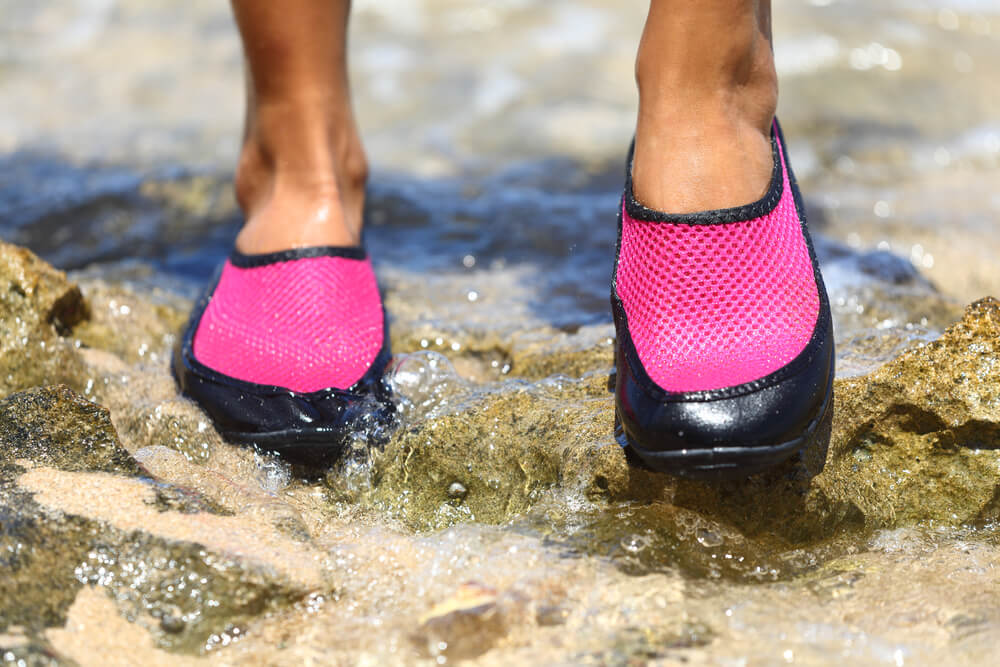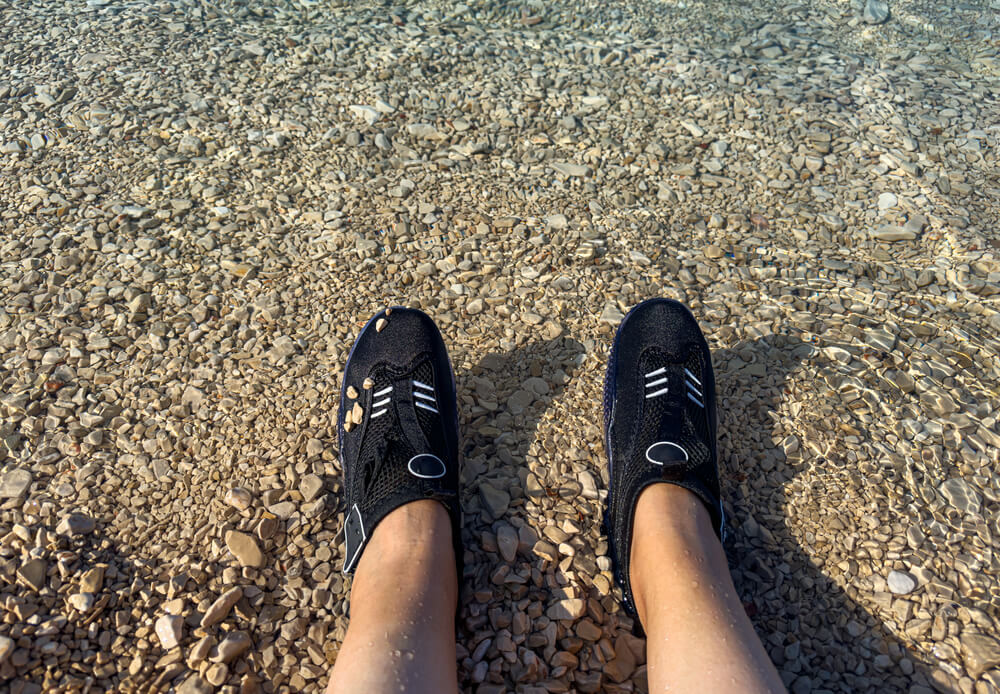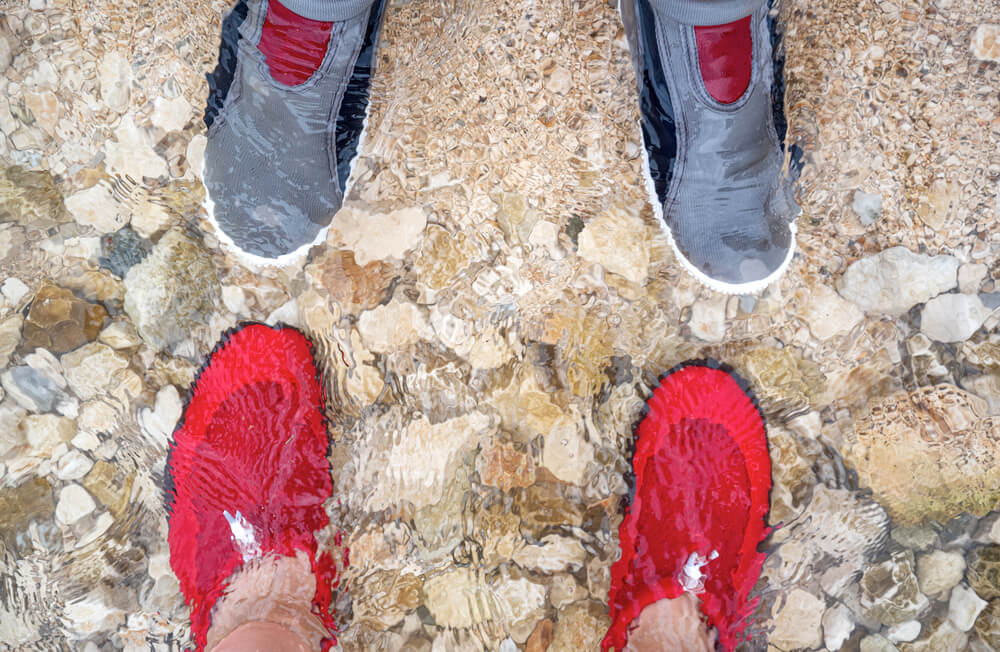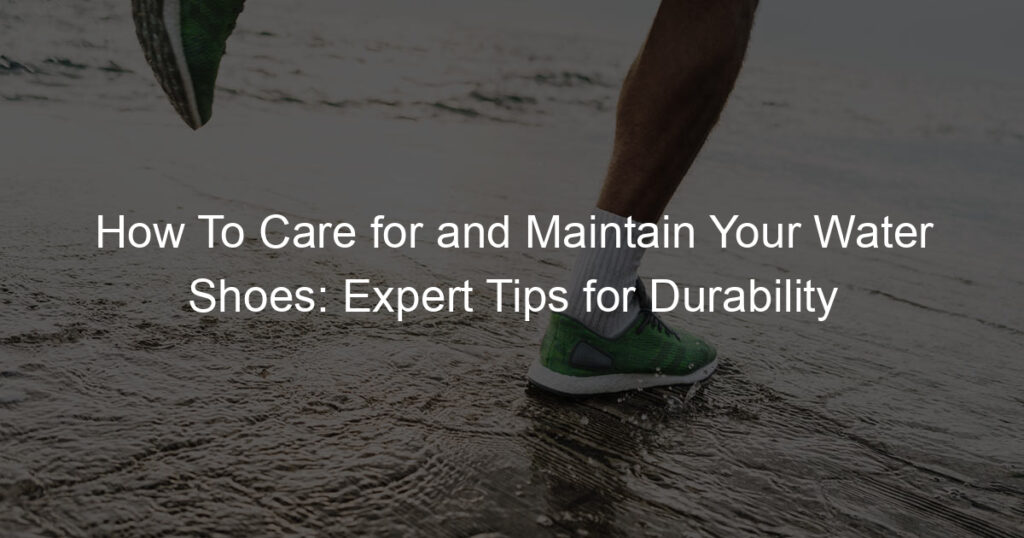Water shoes provide protection, comfort, and traction when engaging in various water-related activities like kayaking, snorkeling, or hiking through shallow waters.
They are specifically designed with quick-drying materials and offer support when navigating slippery or sharp rocks, coral reefs, or other wet surfaces.
But to ensure that your water shoes last for as long as possible, it’s essential to understand how to care for and maintain your water shoes.
Taking care of your water shoes includes regular cleaning, proper drying techniques, and adequate storage to maintain the shoe’s quality and functionality.
Doing this not only prolongs the lifespan of your water shoes but also ensures maximum comfort and hygiene during your water activities.
Key Takeaways
- Regular cleaning and maintenance prolong your water shoes’ lifespan.
- Proper drying techniques prevent odor and bacterial growth.
- Adequate storage is essential for maintaining water shoes’ quality.
How To Care for and Maintain Your Water Shoes

As someone who enjoys water-based activities, I have come to appreciate the importance of water shoes. These shoes are specifically designed for use in and around water, protecting our feet while providing comfort and traction.
In this section, I will discuss the various types of water shoes and the materials commonly used in their construction.
Water shoes are available in different styles to suit various activities such as swimming, kayaking, boating, and paddleboarding.
For example, aqua socks are lightweight and provide minimal protection, making them suitable for swimming and walking on sandy beaches.
On the other hand, rugged water shoes with enclosed toes offer more substantial protection and are ideal for rocky or slippery surfaces.
I have also come across hybrid water shoes that combine the features of sandals and sneakers, providing both ventilation and support for water-based hikes.
When it comes to material choices, water shoes are typically made from rubber, neoprene, nylon, mesh, synthetic materials, and occasionally leather.
Rubber is commonly used for the soles due to its excellent grip and durability.
Neoprene, a type of synthetic rubber, is another popular choice because it provides insulation, cushioning, and quick-drying properties.
Nylon and mesh materials, on the other hand, offer lightweight and breathable options that allow water to drain quickly.
These materials are often combined to create a shoe that meets the specific needs of different water activities.
Understanding the materials used in water shoes is essential for proper care and maintenance.
For example, leather water shoes require different care compared to those made from synthetic materials. Neoprene and rubber shoes might need occasional deodorizing, while nylon and mesh shoes are best cleaned with mild soap and water to prevent damage.
Owning a pair of water shoes has made my water adventures safer and more enjoyable.
Understanding the different types and materials of water shoes can confidently select the right pair for my activities and maintain them for lasting use.
Selecting the Appropriate Water Shoes
When it comes to choosing the right water shoes, I focus on a few significant factors that enhance my overall experience. They are fit and comfortable, with support, laces, and straps.
Firstly, I make sure that the shoes have a snug fit without being too tight or too loose. The ideal fit should allow for natural toe movement and not hinder circulation.
I also consider the thickness of socks I might wear with the water shoes to ensure I select the appropriate size.
Comfort is essential, and I prioritize this feature when selecting my gear. I look for shoes with cushioned insoles and breathable materials.
Mesh panels allow for quick drying and better air circulation, ensuring the shoes remain comfortable to wear for extended periods.
Support is another crucial aspect I never overlook. Water shoes with arch support and a well-structured sole provide stability on different types of surfaces.
This is particularly important when engaging in water-based activities, as the terrain may be uneven or slippery.
I find shoes with adjustable laces or straps to be incredibly practical. They let me customize the fit and make it easy to put them on and take them off.
Elastic laces or hook-and-loop straps provide additional security and stability during various activities.
Lastly, I consider the different styles of water shoes available to match my needs. For instance, if I participate in activities that require extensive foot protection, I might opt for closed-toe shoes.
However, if I need something lighter for casual water sports, I choose slip-on styles which provide easy access and less bulk.
Ultimately, my goal is to select water shoes that balance these factors effectively, resulting in a comfortable, well-supported, and versatile piece of gear to enhance my water-based adventures.
The Importance of Maintaining Water Shoes
Taking good care of my water shoes is crucial in preserving their durability and extending their lifespan.
A well-maintained pair of water shoes provides better protection and support when I engage in water-based activities.
Cleaning my shoes properly is the first step in maintaining them. After use, I make sure to rinse my shoes with clean water to remove any sand, dirt, or small rocks that might have entered during an activity.
To break down stubborn dirt or saltwater deposits, I add a mild detergent to the rinse water.
I understand the importance of correctly drying my water shoes. While it may be tempting to speed up the process, using heat – such as a hairdryer or exposing them to direct sunlight – can damage my water shoes’ materials.
Instead, I chose a well-ventilated area away from direct sunlight to dry them, with the insoles and laces removed to speed up the process.
Proper storage is another essential aspect of maintaining my water shoes. It is best to avoid leaving them damp in a bag or stuffed in a closet.
I always store my water shoes in a cool, dry area, allowing air to circulate freely in order to prevent mold and mildew formation.
Lastly, I inspect my water shoes regularly for any signs of wear and tear, especially around the soles and stitches. This helps me address any potential issues before they become major problems that can compromise the protection and support my water shoes offer.
In cases where damage is beyond repair, investing in a new pair is a better option for ensuring my safety during water activities.
Routine Care for Water Shoes

Caring for and maintaining water shoes is essential to keep them in good condition and ensure they last a long time.
In this section, I will share some tips on routine care for water shoes.
Firstly, it’s important to clean the shoes regularly. I usually clean my water shoes after each use to prevent dirt, sand, and other debris from accumulating.
To clean the shoes, I simply rinse them with clean water, ensuring that I remove any dirt or sand stuck in the shoes. If needed, I use a soft-bristle brush to gently scrub the shoes and remove any stubborn debris.
When it comes to washing water shoes, I prefer using mild soap instead of harsh detergents, as strong chemicals can damage the materials.
I fill a bucket with water and add a small amount of mild soap. Then, I immerse the shoes in the soapy water and gently scrub them with a brush.
After washing, I make sure to rinse the shoes thoroughly to remove any soap residue.
Drying the shoes properly is also crucial in routine care. I avoid exposing my water shoes to direct sunlight for extended periods, as it can cause the material to fade and weaken.
Instead, I place them in a well-ventilated area to air dry, usually hanging them upside down to make sure all the water drains out.
In addition, I also check my water shoes for any signs of wear and tear regularly, as this helps me anticipate when it’s time to replace them. I look for any loose stitching, frayed materials, or worn-out soles that may affect the shoe’s performance.
By following these simple steps in my routine care for water shoes, I ensure that they remain in excellent condition and provide me with the best performance during water activities.
Dealing with Specific Contaminants
When I take my water shoes to the beach, sand is a common issue. I deal with this by first rinsing the shoes with fresh water to remove any loose sand.
Next, I use a soft brush to gently scrub away any remaining sand that may be lodged in the fabric or soles.
Dirt and debris can also make their way into my water shoes during outdoor activities. When this happens, I create a mixture of water and mild detergent to clean them.
I make sure to properly saturate the shoes and use a soft cloth or brush to remove the dirt and debris in a circular motion. After cleaning, I rinse the shoes thoroughly with fresh water to eliminate any detergent residue.
Grime buildup can be an issue as well, especially if the shoes are frequently used in water with pollutants. To tackle grime, I soak my water shoes in a solution of water and white vinegar (1:1 ratio) for about 30 minutes.
This helps to break down the grime and restore the shoes’ original appearance. After soaking, I scrub any remaining grime using a soft brush.
To ensure the longevity of my water shoes, I avoid using harsh cleaning agents like bleach or alcohol. Instead, I stick to mild detergents and white vinegar.
Additionally, I make it a point to check the care instructions provided by the manufacturer to prevent any damage during cleaning.
Addressing specific contaminants like sand, dirt, debris, and grime can properly maintain my water shoes and keep them looking and feeling fresh for every adventure.
Drying Techniques

When it comes to drying water shoes, there are several techniques I like to use to ensure they remain in good condition. To help maintain the shape and structure of the shoes, it’s essential to dry them properly after each use.
One effective method is to air dry the shoes. By placing them in a well-ventilated area with good air circulation, I can quickly dry my water shoes without causing damage.
To speed up the process, it’s also useful to remove any excess water by gently pressing the shoes with a clean towel before air drying.
Another option is to stuff the shoes with newspaper. This not only helps absorb moisture but also allows the shoes to maintain their shape while drying.
You may want to replace the newspaper every few hours until the shoes are completely dry.
Using a fan can also facilitate faster drying. By positioning the water shoes near a fan, the constant air movement helps evaporate the moisture quickly.
Nonetheless, it’s crucial to ensure the shoes are not placed too close to direct heat or a heat source, as this could cause damage to the material.
In conclusion, drying water shoes correctly is vital for prolonging their lifespan and maintaining optimal performance.
By utilizing techniques such as air drying, using a towel, or stuffing them with a newspaper, you can ensure your water shoes are always ready for your next aquatic adventure.
Tips to Prevent and Eliminate Odor
When it comes to water shoes, the key is to deal with odor and related issues proactively. I’ve gathered some essential tips to prevent and eliminate bad smells, harmful bacteria, mold, and mildew from your water shoes.
First, it’s crucial to rinse them off thoroughly after each use. This step will help remove any dirt, sand, or other debris that can harbor bacteria and create unpleasant smells.
Rinsing your shoes with a mix of water and mild detergent can prevent most bacterial and fungal growth by keeping the shoes clean.
Next, let’s talk about drying. Air drying is the most effective way to eliminate moisture and prevent odor in your water shoes. As soon as you remove your shoes, turn them inside out and try to remove any excess moisture by shaking them or patting them dry using a towel.
Place them in a well-ventilated area where air can circulate freely, ensuring that the shoes will dry out completely.
Avoid drying your shoes in direct sunlight, though, since this can damage the materials and reduce their lifespan.
To further keep unpleasant smells at bay, you might want to try some sneaky tricks like using dryer sheets. Placing a dryer sheet in each shoe when you’re not wearing them can help absorb moisture and release a pleasant fragrance.
Make sure you replace the dryer sheets regularly, as their effectiveness will decrease over time.
Finally, store your water shoes in a cool, dry place with good airflow. It is best not to toss them into a closed bag or container, as these spaces can trap moisture and create an environment that encourages bacterial growth and odor.
Instead, try using a breathable mesh bag to keep everything tidy without sacrificing airflow.
Following these simple tips can help prevent unpleasant odors and ensure that your water shoes are always fresh and ready for your next aquatic adventure.
Specific Care for Different Materials

When caring for water shoes, it’s important to be aware of the various materials they’re made from, as different materials require specific care.
Let’s discuss the best methods for maintaining each material type.
For PU and leather shoes, cleaning and airing them out properly is essential. I use a damp cloth or sponge to wipe off any dirt without soaking the shoe. It’s crucial to avoid using any harsh chemicals, as they may damage the leather. I always air dry them, making sure to keep them away from direct sunlight or heat sources.
Rubber and neoprene water shoes are relatively easy to clean. After using them, I usually rinse mine thoroughly with fresh water to remove debris, making sure to clean the soles too. If needed, I gently scrub them with a soft brush and mild detergent. Then, I let them air dry away from direct sunlight, which can cause the material to deteriorate or discolor.
Mesh and nylon materials require gentle cleaning. I typically hand wash my mesh and nylon shoes in lukewarm water with a mild detergent, taking care to remove all sand and debris. I then rinse them thoroughly with fresh water and gently press out any excess water before allowing them to air dry. It’s important not to twist or wring the shoes, as it can damage their shape.
Suede water shoes require extra care to preserve their unique texture. After a day of use, I brush off any dirt with a soft-bristled brush, making sure I’m not applying too much pressure. For more persistent stains, I use a suede cleaning solution following the manufacturer’s instructions. Air drying is essential, and I always avoid exposing them to direct sunlight or heat.
For synthetic materials, I find they can generally be treated in a similar manner to mesh and nylon materials. Hand washing them with a mild detergent is effective at removing dirt and debris, followed by thorough rinsing and air drying.
Properly caring for water shoes, I can ensure their longevity and maintain their functionality, keeping my feet comfortable and protected during water activities.
Water Shoes and Activities
I use water shoes for a variety of water-related activities, such as hiking, swimming, and kayaking. They offer excellent traction and protection on slippery surfaces, making them an essential piece of gear for many water-based adventures.
When I go hiking through wet or rocky terrain, my water shoes provide the support and grip necessary to navigate slippery trails while keeping my feet comfortable and dry.
If I plan to swim or wade in a river, my water shoes ensure that I don’t accidentally step on sharp objects like rocks or submerged debris.
Kayaking is another favorite activity of mine, and water shoes play an important role in my safety and comfort. They not only provide excellent grip on my kayak’s wet surfaces but also protect my feet from rocks or other hazards as I enter and exit the water.
To maintain my water shoes in the best possible condition, I follow a few simple care tips. After each use, I make sure to rinse them thoroughly with fresh water to remove any salt, sand, or dirt.
Then, I let them air dry away from direct sunlight, as intense heat can damage the materials over time.
Furthermore, I occasionally inspect my water shoes for any signs of wear or damage. If I notice any issues, such as tears in the fabric or worn-out soles, I promptly replace them to ensure my feet remain protected during my water-related activities.
By caring for and maintaining my water shoes, I can confidently engage in a range of water-based adventures, knowing that my footwear is designed to ensure both safety and comfort.
Storage and Conditioning of Water Shoes
I always make sure to protect my water shoes from damage and ensure they remain in good condition. Proper storage and conditioning play a critical role in their longevity.
To keep my water shoes in the best possible shape, I start by removing excess water from them as soon as I am done wearing them. I gently squeeze the shoes to remove any lingering water and then lay them out on a flat surface to air dry.
If possible, I try to make sure this surface is in a well-ventilated area, as this helps speed up the drying process.
Once my shoes are completely dry, I place them in a storage area where they can be protected from dust, dirt, and direct sunlight.
Storing water shoes in a cool, dry location is important to maintain their lifespan and avoid any damage from the harsh sun or excess humidity.
In addition to proper storage, I also condition my water shoes regularly. This includes cleaning them with mild soap and water to remove dirt, sand, and other debris after each use.
Afterward, I allow the shoes to air dry, ensuring they are completely dry before their next use.
By taking these steps to care for my water shoes, I am confident in their performance and can enjoy my water activities without any worries about the quality of my footwear.
With proper care, my water shoes continue to provide me with comfort, protection, and durability each time I wear them.
Avoiding Damages to Water Shoes

I have found that one of the key factors in maintaining the longevity of my water shoes is to avoid damages caused by improper use or storage.
Now I will share some tips on how to properly care for and maintain your water shoes to minimize damages and ensure their durability.
Firstly, I always make sure to clean my water shoes thoroughly after each use. This means removing any sand, dirt, or debris that may be present in the shoes.
Doing so prevents abrasive materials from wearing down the soles of the shoes or causing other forms of damage.
Another important aspect of maintenance is regularly inspecting the soles for wear and tear. The soles are the part of the water shoes that protect my feet from sharp objects, and as such, they need to be in top condition.
If I notice any thinning or deterioration, I consider replacing the shoes.
Additionally, it is essential to avoid exposing water shoes to extreme heat or direct sunlight for extended periods of time, as this can cause the materials to break down or become brittle.
When I am not using my shoes, I store them in a cool, dry place away from direct sunlight.
Moreover, I always avoid walking on sharp objects or rough terrain while wearing my water shoes. Although it might be tempting to explore rocky shores or traverse grinding surfaces, these actions can quickly wear down and damage the shoes.
Instead, I opt for smooth, sandy beaches or cushioned pool areas.
Lastly, I make sure that my water shoes are completely dry before storing them. Excess moisture can lead to the growth of mold or mildew, which are harmful to the materials and can produce unpleasant odors.
To speed up the drying process, I place them near a ventilated area or use a fan to circulate air around them.
Following these simple steps and being mindful of the potential hazards can effectively maintain my water shoes and enjoy their benefits for a long time.
Washing Water Shoes in the Machine
I find using a washing machine to clean my water shoes very convenient, as long as I follow some simple guidelines. To begin, I remove any excess dirt or sand from my shoes before placing them in the machine.
If they are particularly dirty, I might even rinse them off with a hose or in a sink before washing them.
When washing my water shoes, I prefer to use a gentle detergent specifically designed for delicate fabrics. Some detergents can cause damage to the shoes’ materials and reduce their lifespan.
I never use bleach, as it can break down the materials and cause discoloration.
To ensure a gentle wash for my water shoes, I usually set the machine on a delicate cycle and use lukewarm water. This not only protects the shoes but also helps to prevent any shrinkage or warping.
If my machine doesn’t have a delicate cycle, I sometimes place the shoes in a mesh laundry bag for added protection.
Once the cycle is complete, I avoid using a dryer, as the heat can damage the material and weaken the glue that holds the shoes together.
Instead, I simply air dry my water shoes by placing them in a well-ventilated area away from direct sunlight. It’s important to ensure that they are completely dry before storing them away to prevent any mold or mildew growth.
Following these steps can easily keep my water shoes fresh and functional, extending their life and making them ready for my next aquatic adventure.
Detailed Step-by-Step Cleaning Guide
To keep my water shoes in top condition, I follow these steps for cleaning and maintaining them:
- Prepare: Before cleaning, I make sure to remove any loose dirt or debris from my water shoes. I do this by shaking them out and using a soft brush to gently remove any particles that may be stuck in the grooves of the soles.
- Rinse: After preparing my shoes, I rinse them thoroughly with cold water. This helps remove any remaining dirt or sand and prepares the shoes for cleaning. It’s essential to rinse both the inside and outside of the shoes.
- Clean: To clean my water shoes, I use a mild soap or detergent that’s safe for synthetic materials. I mix a small amount of the soap with water, then use a soft brush to gently scrub the shoes both inside and out. While cleaning, I pay attention to areas such as the seams, where dirt can accumulate over time.
- Wash: Once I’ve cleaned my water shoes, it’s time to rinse them again. This step is important to remove any soap residue and ensure all dirt has been removed. I hold the shoes under running water and gently squeeze them to help flush out any remaining suds.
- Dry: Drying my water shoes properly is vital to prevent mold and mildew growth. I begin by pressing a towel against my shoes to absorb excess water. Then, I place the shoes in a well-ventilated area to air dry. To speed up the drying process, I sometimes use a fan or open a window. It’s crucial not to use direct heat, such as a hairdryer, as this can damage the materials and weaken the glue that holds the shoes together.
- Condition: Once my water shoes are clean and dry, I use a specialized conditioner designed for synthetic materials to help keep them supple and extend their lifespan. I apply a small amount of the conditioner to a soft cloth and gently rub it into the surface of the shoes, avoiding the soles.
Following these steps, I can keep my water shoes in excellent condition, ensuring they’re ready to protect my feet during various water activities.
Frequently Asked Questions
What is the best method to clean water shoes?
To clean water shoes, I recommend using a mixture of warm water and mild detergent. Gently scrub the shoes with a soft brush, focusing on areas with visible dirt or mud.
Rinse them thoroughly to remove any soap residue, and allow them to air dry naturally, avoiding direct sunlight or heat sources.
Are there specific tips for washing certain brands of water shoes?
While most water shoes can be washed using the method mentioned above, I encourage you to check the manufacturer’s recommendations for specific brands and models.
Some may have special care instructions or require the use of particular cleaning agents to maintain their materials and performance.
How can I prevent my water shoes from developing odors?
To prevent odors, make sure to let your water shoes dry completely after each use. Consider using odor-absorbing products, such as antibacterial shoe sprays or charcoal shoe deodorizers, to keep your shoes smelling fresh.
Further, washing them regularly can help combat odor-causing bacteria.
How often should water shoes be cleaned and maintained?
The frequency of cleaning and maintenance depends on how often you use your water shoes and the environmental conditions. If you use them frequently in muddy or dirty water, they will require more frequent cleaning.
Generally, I recommend cleaning water shoes every 3-5 wears or after they have been exposed to particularly harsh conditions.
Do water shoes have a typical lifespan?
The lifespan of water shoes can vary depending on the quality of materials, construction, and frequency of use. Typically, quality water shoes can last anywhere from 1 to 3 years.
To prolong their life, take care of them by washing and maintaining them properly.
Can water shoes be used for day-to-day activities?
Water shoes are designed for activities involving water, so they may not provide maximum comfort and support for day-to-day activities. However, they can be used for casual walks, errands, or other light activities when needed.
Keep in mind that they may wear out faster when used outside their intended purpose.









